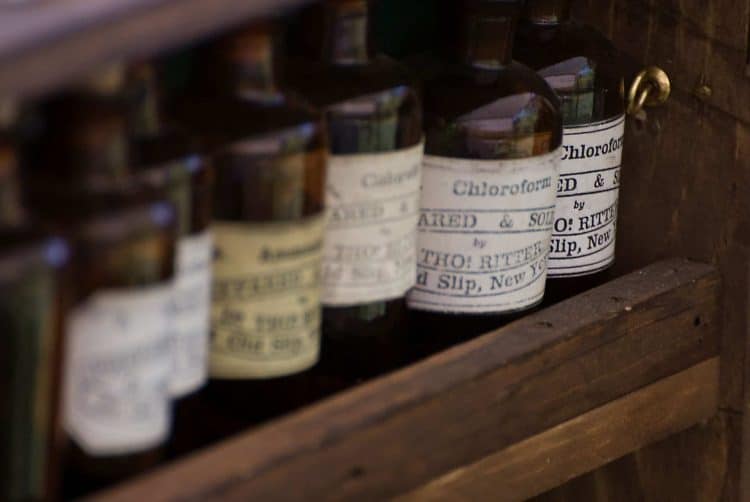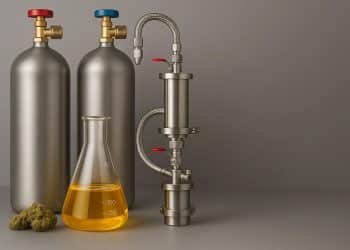Residual solvents may adversely affect cannabis concentrate quality and the consumer’s health. Generally they are the result of unpurified extract; vacuum ovens are one tool to remove hydrocarbon solvents. Residual solvents may also be introduced during cleaning (e.g., isopropyl alcohol). State-level cannabis testing regulations require at least some analytical testing for residual solvents in legal cannabis. The United States Pharmacopeia (USP) <467> provides guidelines that inform some programs. Nonetheless, cannabis testing requirements vary by region.
Residual solvents requiring testing may include chloroform, benzene, acetone, methanol, toluene, and many others with varying degrees of toxicity. [1,2] The tables below summarize the requirements of seven different states for five residual solvents to illustrate regulatory differences (the list is by no means exhaustive).
| State | Residual Limit (ppm) | Products |
| Alaska | 800 | Solvent-based concentrates |
| California | 5,000 | All |
| Maine | 5,000 | All |
| New Mexico | 800 | Solvent-based |
| Oklahoma | 1,000 | Food/infusions |
| Pennsylvania | 5,000 | Extraction-based |
| Utah | 5,000 | All |
| State | Residual Limit (ppm) | Products |
| Alaska | N/A | N/A |
| California | 5,000 | All |
| Maine | 5,000 | All |
| New Mexico | 800 | Solvent-based |
| Oklahoma | 1,000 | Food/infusions |
| Pennsylvania | N/A | N/A |
| Utah | 5,000 | All |
Hexane
| State | Residual Limit (ppm) | Products |
| Alaska | 10 | Solvent-based concentrates |
| California | 70
290 |
Inhalable
All other |
| Maine | 290 | All |
| New Mexico | 250 | Solvent-based |
| Oklahoma | 60 | Food/infusions |
| Pennsylvania | N/A | N/A |
| Utah | 290 | All |
| State | Residual Limit (ppm) | Products |
| Alaska | N/A | N/A |
| California | 5,000 | All |
| Maine | 5,000 | Oral & topical products exempt |
| New Mexico | N/A | N/A |
| Oklahoma | N/A | N/A |
| Pennsylvania | 5,000 | Extraction-based products |
| Utah | 5,000 | All |
Benzene
| State | Residual Limit (ppm) | Products |
| Alaska | 1 | Solvent-based concentrates |
| California | 1 | All |
| Maine | 1 | All |
| New Mexico | 2 | Solvent-based |
| Oklahoma | 2 | Food/infusions |
| Pennsylvania | N/A | N/A |
| Utah | 2 | All |
The 5,000 ppm limits for hexane, propane, and ethanol reflect USP <467>, which considers these solvents less harmful and defers to Good Manufacturing Practice guidelines. Extractors must nonetheless be aware that more harmful solvents may co-occur. For example, purified ethanol may contain small amounts of benzene. Butane may also contain harmful contaminants. This is one reason why programs require rigorous testing for trace amounts of solvents that seem irrelevant.
Although ethanol is sometimes considered a non-priority, at least one study has suggested that inhaling residual ethanol may cause dependence and other negative effects. [3] Sufficient levels are known to intoxicate and potentially damage lung tissue. On the other hand, a 2019 case study profiled the case of an 18-year-old individual who suffered severe pneumonitis after using illicit butane hash oil. [4] The injury was likely due to “an unknown level of pure butane.” [4] Ultimately, untested concentrates are dangerous.
References
- Valdes-Donoso P, et al. Costs of cannabis testing compliance: Assessing mandatory testing in the California cannabis market. PLOS ONE, 2020;15(4): e0232041.doi:10.1371/journal.pone.0232041. [Impact Factor: 2.740; Times Cited: n/a]
- Nate S. Cannabis contaminants: Regulating solvents, microbes, and metals in legal weed. Environ Health Perspect. 2020;127(8):82001. doi:10.1289/EHP5785. [Impact Factor: 8.05; Times Cited: 2]
- MacLean RR, et al. Inhalation of alcohol vapor: Measurement and implications. Alcohol Clin Exp Res. 2017;41(2):238-250. doi:10.1111/acer.13291. [Impact Factor: 3.235; Times Cited: 16]
- Anderson RP, Zechar K. Lung injury from inhaling butane hash oil mimics pneumonia. Respir Med Case Rep. 2019;26:171-173. 2019. doi:10.1016/j.rmcr.2019.01.002. [Impact Factor: n/a; Times Cited: 21]
Image: Kevin King, CC By-2.0












